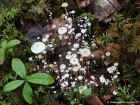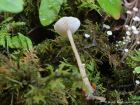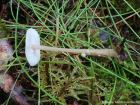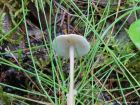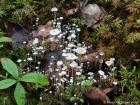Cap very small, convex with an inrolled margin when young, becoming broadly convex to flat, sometimes with a slight central depression. The surface is smooth, dry to moist, whitish to pale buff, occasionally with a faint pinkish or brownish tinge near the centre. The flesh is whitish and extremely thin. Gills attached to the stem, close to almost distant, whitish to pale pinkish, narrow. Stem very slender, equal or slightly tapering, whitish to pinkish and becoming hollow with age. The base is attached to a small, reddish-brown, tear-shaped or elliptical sclerotium resembling an apple seed. The stem has no ring. Spore print white.
Microscopic Features: Spores are 4–6 × 3–3.5 µm, smooth, ellipsoid to sublacrymoid, and inamyloid.
Collybia tuberosa on the www.first-nature.com web site.
Collybia tuberosa on the MushroomExpert.Com Web site.
Many mushrooms are poisonous, and some can be lethally toxic. Distinguishing between edible and poisonous mushrooms can be very challenging. Therefore, we strongly advise against consuming wild mushrooms. This website does not contain any information about the edibility or toxicity of mushrooms.
Although efforts have been made to ensure accuracy on this website, the information may contain errors and omissions. Therefore, all content provided is for educational and informational purposes only and should not be relied upon or used as a basis for consuming any plants or mushrooms.
External links are provided for reference only. We do not endorse or take responsibility for the content, advice, or products found on these sites or in any advertisements shown on this website.
